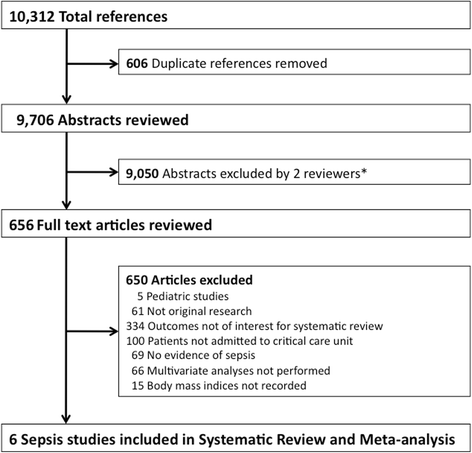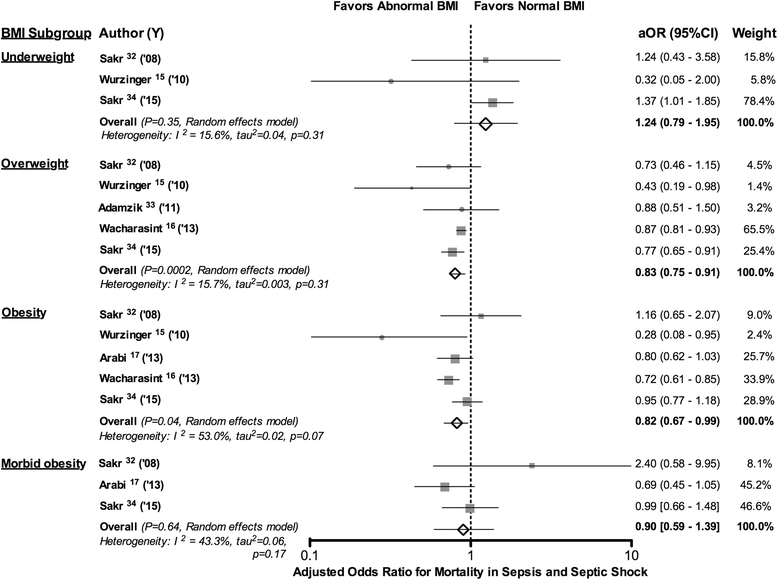Increased body mass index and adjusted mortality in ICU patients with sepsis or septic shock: a systematic review and meta-analysis
- PMID: 27306751
- PMCID: PMC4908772
- DOI: 10.1186/s13054-016-1360-z
Increased body mass index and adjusted mortality in ICU patients with sepsis or septic shock: a systematic review and meta-analysis
Abstract
Background: At least 25 % of adults admitted to intensive care units (ICU) in the United States have an overweight, obese or morbidly obese body mass index (BMI). The effect of BMI on adjusted mortality in adults requiring ICU treatment for sepsis is unclear. We performed a systematic review of adjusted all-cause mortality for underweight, overweight, obese and morbidly obese BMIs relative to normal BMI for adults admitted to the ICU with sepsis, severe sepsis, and septic shock.
Method: PubMed, the Cochrane Library, and EMBASE electronic databases were searched through November 18, 2015, without language restrictions. We included studies that reported multivariate regression analyses for all-cause mortality using standard BMI categories for adults admitted to the ICU for sepsis, severe sepsis, and septic shock. Articles were selected by consensus among multiple reviewers. Electronic database searches yielded 10,312 articles, of which six were eligible. Data were extracted by one reviewer and then reviewed by three independent reviewers. For the meta-analyses performed, the adjusted odds ratios (aOR) of mortality were combined using a random-effects model. Risk of bias was assessed using the Newcastle-Ottawa quality assessment scale for cohort studies.
Results: Four retrospective (n = 6609 patients) and two prospective (n = 556) studies met inclusion criteria. Compared to normal BMI, across five studies each, overweight or obese BMIs reduced the adjusted odds ratio (95 % CI) of mortality [aOR] [0.83 (0.75, 0.91) p < 0.001 and 0.82 (0.67, 0.99) p = 0.04, respectively] with low or moderate heterogeneity (I(2) = 15.7 %, p = 0.31 and I(2) = 53.0 %, p = 0.07, respectively). Across three studies each, morbidly obese BMI and underweight BMI did not alter aOR [0.90 (0.59, 1.39), p = 0.64; I(2) = 43.3 %, p = 0.17; and 1.24 (0.79, 1.95), p = 0.35; I(2) = 15.6 %, p = 0.31 respectively]. Only one study clearly defined how and when height and weight measurements were calculated. Site of underlying infection and illness severity may have favored overweight and obese BMIs.
Conclusions: This is the first meta-analysis to show that overweight or obese BMIs reduce adjusted mortality in adults admitted to the ICU with sepsis, severe sepsis, or septic shock. More rigorous studies that address these limitations are needed to clarify the impact of BMI on sepsis ICU outcomes.
Trial registration: PROSPERO International prospective register of systematic reviews 10.15124/ CRD42014010556 . Registered on July 11, 2014.
Keywords: Body mass index; Meta-analysis; Mortality; Obesity; Overweight; Sepsis.
Figures


References
Publication types
MeSH terms
LinkOut - more resources
Full Text Sources
Other Literature Sources
Medical
Miscellaneous

